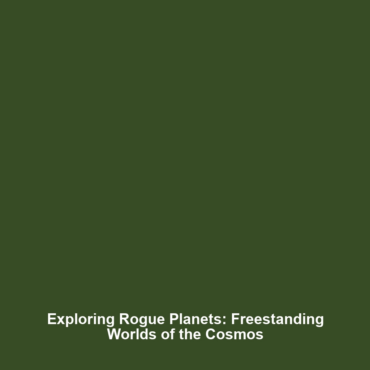Rogue Planets: The Intriguing Celestial Drifters
Introduction
Rogue planets are extraordinary celestial bodies that do not orbit any star, drifting through the vast expanses of space on their own. These elusive entities are significant not only for their mysterious nature but also for the insights they provide into planetary formation and the dynamics of our galaxy. Understanding rogue planets expands our knowledge about the universe and the multitude of exoplanets that inhabit it. As more discoveries are made, the study of rogue planets continues to capture the interest of astronomers and the public alike.
Key Concepts of Rogue Planets
Definition and Characteristics
Rogue planets, often referred to as interstellar or free-floating planets, are defined by their lack of a stable orbit around a star. These planets can originate through various mechanisms:
- Gravitational Interactions: Some rogue planets may be ejected from their home solar systems due to gravitational interactions with massive bodies or during the chaotic early stages of planetary formation.
- Failed Star Formation: Others may form in isolation without ever acquiring enough mass to ignite nuclear fusion, preventing them from becoming stars.
Classification within Exoplanets
Rogue planets are an essential part of the broader category of exoplanets, which includes any planet located outside our solar system. Their ability to exist independently challenges our conventional understanding of planetary systems and opens up new avenues for research within exoplanet studies. Keywords like rogue planets and exoplanets contribute to ongoing discussions about planetary diversity and evolution in the universe.
Applications and Real-World Uses
The study of rogue planets provides valuable insights, leading to several significant applications:
- Astronomical Modeling: Insights gained from studying rogue planets help astronomers understand the dynamics of celestial formation and behavior.
- Planetary Habitability Theories: Investigations into rogue planets may inform astrobiology and theories about potential life-sustaining environments outside conventional star systems.
Understanding how rogue planets function within the category of exoplanets helps in developing our techniques for detecting and analyzing these fascinating objects.
Current Challenges
Despite the intriguing nature of rogue planets, several challenges persist in their study:
- Detection Limitations: Rogue planets are difficult to identify due to their low luminosity and distance from stars.
- Uncertainties in Origin: The mechanisms that lead to the formation and ejection of rogue planets remain poorly understood.
- Technological Constraints: Current observational techniques may not be advanced enough to study rogue planets in great detail.
Addressing these challenges is essential for advancing our knowledge of rogue planets as part of the broader exoplanetary field.
Future Research and Innovations
Looking ahead, advancements in technology and research methodologies are expected to enhance our understanding of rogue planets:
- Next-Gen Telescopes: Upcoming telescopes, such as the James Webb Space Telescope, promise improved capabilities for detecting faint celestial objects, including rogue planets.
- Innovative Survey Techniques: New methods for large-scale astronomical surveys can potentially uncover more rogue planets and contribute to our understanding of their properties.
- Astrobiological Research: Ongoing studies may reveal more about the conditions necessary for life, even in the absence of a star.
Conclusion
Rogue planets, drifting through the cosmos without a parent star, represent one of the many captivating mysteries of our universe. Their study not only enriches our understanding of planetary systems but also poses significant questions about the potential for life beyond stars. As we continue to explore these intriguing celestial drifters, we encourage readers to delve deeper into the topics of exoplanets and rogue planets to uncover the wonders that await us in the expansive universe.

Leave a Reply